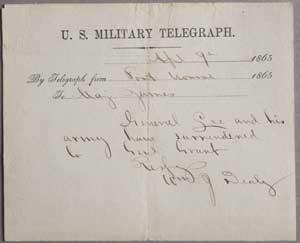What do a tattered diary, a rusty bayonet and a stained and torn 140-year-old telegram have in common? They can all help bring new life to our understanding of compelling events connected with the Civil War, but the artifacts' poor condition put them at risk for continued deterioration'and therefore made them unsuitable for public display.
That would be a shame, because the objects in question include at least one that would likely cause a stir if it turned up on the Antiques Road Show.
The military telegram, which was sent on April 9, 1865, carried momentous news: General Robert E. Lee had surrendered at Appomattox, Virginia. Less than a week later, the nation was shocked by the assassination of Abraham Lincoln. How did one "average" civilian feel about that event? We can get a glimpse via a pocket diary that belonged to New York resident John Righter.
Donation Makes Project Possible
Thanks to a $300,000 donation from the Gettysburg Foundation, the telegram and diary are among more than 150 artifacts that are being conserved by experts at the National Park Service's Harpers Ferry Center. Once that work is completed later this year, the objects will be placed on public display at the museum and visitor center at Gettysburg National Military Park.
Even under the best of conditions, public display takes a toll on historic objects, so the availability of these new items will also allow other artifacts currently on view to be returned to more protected storage conditions for a bit of "rest."
Conservation of historic items requires special skills and techniques, and fabric and paper items can be especially challenging. A flag in the collection headed to Gettysburg required about 120 hours of painstaking conservation work. When that 1865 diary was donated to the park, it had a partially detached spine, tears to the pages, and accumulated surface dirt. Such damage is common to books from this time period, but making it safe and ready for exhibit involved reattaching the binding threads, mending the page tears with Japanese paper and wheat starch paste, and reinforcing the covers to prevent further damage.

The 1865 telegram after conservation work. NPS photo by Gary Tarleton.
New Life For An Historic Message
The 1865 military telegram had similar issues. NPS conservators used a number of techniques to surface-clean the brittle, stained, and torn document. After tears were mended, the object was humidified to allow proper mounting on a new archivally-sound mat board before reframing.
Metal objects left in the ground for decades pose their own set of challenges. One example is an English-made Model 1853 saber bayonet which was recovered from the Gettysburg battlefield in the vicinity of the Henry Spangler Farm. The weapon dates to about 1860, and rust was present across the entire bayonet; it was particularly heavy on the guard. In order to stabilize it for exhibit, conservators cleaned the item both mechanically and chemically and then coated it with microcrystalline wax at a temperature of 195 degrees.
You'll find other examples of artifacts with "before" and "after" photos of the conservation work on "From the Fields of Gettysburg," the official blog of Gettysburg National Military Park.
If you'd like to plan a visit to Gettysburg to view the battlefield and museum first-hand, you'll find plenty of useful information on the park website.


 Support Essential Coverage of Essential Places
Support Essential Coverage of Essential Places







Add comment